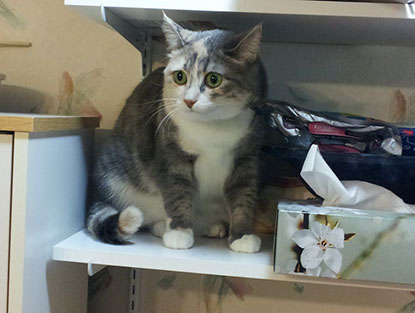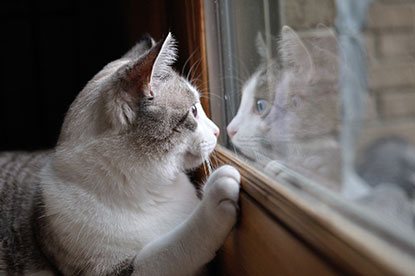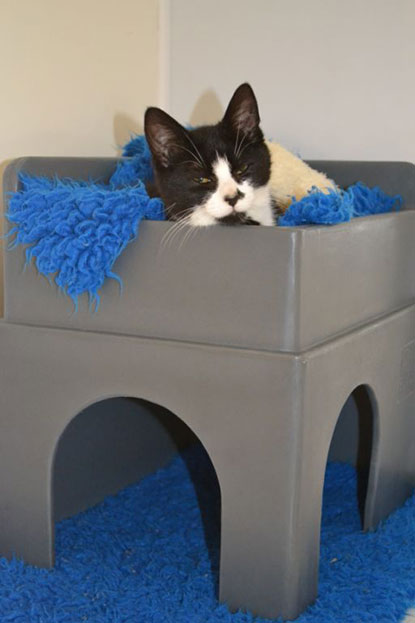Cats
In this week’s behaviour focus post, Cats Protection Behaviour Manager Nicky Trevorrow explains why a cat may hide more frequently.
My cat has recently started hiding more. I’ve tried to reassure her but it doesn’t seem to help.
It is important to ensure that there are no medical reasons that could be causing this behaviour, especially as this is a recent change. Cats are very subtle in their behaviour when something is wrong and it is very easy to overlook an increase in hiding behaviour. This stems from also being a prey animal as well as a predator so they try to hide signs of vulnerability. Discuss the change in your cat’s behaviour with your vet as they will have access to their medical history. Hiding behaviour could just be one sign and it is possible that your cat could have a number of behavioural and/or medical problems. If the vet has ruled out medical reasons then there could be a number of behavioural reasons that could cause a change in your cat’s behaviour. The best way to identify the underlying cause is to get a referral from your vet to a qualified behaviourist such as a member of the Association of Pet Behaviour Counsellors (www.apbc.org.uk).
In the meantime, general measures that you can take to help your cat feel safe include providing your cat with lots of opportunities to hide and get up high to elevated perches. Try not to disturb cats when they are hiding. You can easily provide extra hiding places by placing lots of cardboard boxes around the house.
Cats can hide more frequently for all kinds of reasons. A common reason is stress caused by the presence of other cats. If your cat is worried about another cat in the garden, then check the cat’s entry and exit points. You may not even notice another cat as they can be very sneaky! They could even be entering the house without you realising. If you have an ordinary cat flap, it is an open invitation for other cats in the neighbourhood to grab an extra meal. Protect your cat’s territory with a microchip cat flap that reads your cat’s unique microchip number and will only let your cat back into the house. Alternatively, you could try a magnetic cat flap, whereby the cat wears the accompanying magnet on a quick release collar.
Think about additional ways that other cats could gain access to the house too. Be careful to keep doors and windows shut. You may need to block your cat flap with a solid panel on the inside and outside of the flap. This helps to give a clear message to both the resident cat and the intruder that the house is secure. In the absence of free access, you will need to be the door monitor for your cat and often the bodyguard in the garden to protect them from other cats.
Cats that are feeling threatened by other cats will often spend a lot of time being vigilant at windows and cat flaps. It can therefore help to cover the windows, at cat height (don’t live in the dark!), with something opaque so your cat can’t see other cats.
Many owners try to cuddle or fuss their cat to try and reassure them. While this is a natural thing to want to do as it would often reassure fellow humans, cats are very different to us. They would prefer to run away, get up high and hide, and research indicates that by doing these things, cats’ stress levels will reduce. It may seem unnatural or even unkind to us, but the best way to help your cat is to provide plenty of hiding places, escape routes and elevated perches and, most importantly, let them hide.
For more information, check out our leaflet Managing your cat’s behaviour and the free Cats Protection online behaviour course: http://learnonline.cats.org.uk/ufo
- Behaviour Focus: Inappropriate Play
In this week’s behaviour focus post, Cats Protection Behaviour Manager Nicky Trevorrow explains why a cat may show misdirected predatory play behaviour. Why does my cat attack people’s legs when they walk past? If you've read any of my other...
- Behaviour Focus: Night Time Waking
In this week’s behaviour focus post, Cats Protection Behaviour Manager Nicky Trevorrow discusses why a cat may wake and disturb you through the night. Why does my cat keep waking me up in the night? Most cat owners are familiar with their cat...
- ‘why Does My Cat Dribble?’ And Other Feline Behaviour Faqs
It’s that time again – every two weeks a feline expert at Cats Protection takes over our Facebook page to answer your cat care questions. This week it was the turn of behaviour specialist Nicky Trevorrow. Here are just some of the cat behaviour questions...
- Feline Behaviour Explained – Recognising Stress In Your Cat’s Face
In the last of a three-part series of visual guides to cat behaviour, we’re sharing some examples of facial expressions that will help you to identify how your cat is feeling and when they may be getting stressed. This is a general guide so your cat...
- ‘why Is My Cat Spraying?’ And Other Cat Behaviour Faqs
Following our recent survey which revealed that many cat owners do not recognise the signs of stress, we hosted a live Q&A session on our Facebook page focusing on cats and stress. Our supporters asked questions which were answered by Nicky Trevorrow,...
Cats
Behaviour focus: hiding
In this week’s behaviour focus post, Cats Protection Behaviour Manager Nicky Trevorrow explains why a cat may hide more frequently.
My cat has recently started hiding more. I’ve tried to reassure her but it doesn’t seem to help.
It is important to ensure that there are no medical reasons that could be causing this behaviour, especially as this is a recent change. Cats are very subtle in their behaviour when something is wrong and it is very easy to overlook an increase in hiding behaviour. This stems from also being a prey animal as well as a predator so they try to hide signs of vulnerability. Discuss the change in your cat’s behaviour with your vet as they will have access to their medical history. Hiding behaviour could just be one sign and it is possible that your cat could have a number of behavioural and/or medical problems. If the vet has ruled out medical reasons then there could be a number of behavioural reasons that could cause a change in your cat’s behaviour. The best way to identify the underlying cause is to get a referral from your vet to a qualified behaviourist such as a member of the Association of Pet Behaviour Counsellors (www.apbc.org.uk).
 |
| Cats are likely to get up high if they feel stressed; photo by Napolean_70 via flickr |
Cats can hide more frequently for all kinds of reasons. A common reason is stress caused by the presence of other cats. If your cat is worried about another cat in the garden, then check the cat’s entry and exit points. You may not even notice another cat as they can be very sneaky! They could even be entering the house without you realising. If you have an ordinary cat flap, it is an open invitation for other cats in the neighbourhood to grab an extra meal. Protect your cat’s territory with a microchip cat flap that reads your cat’s unique microchip number and will only let your cat back into the house. Alternatively, you could try a magnetic cat flap, whereby the cat wears the accompanying magnet on a quick release collar.
 |
| This cat is being vigilant for other cats in the neighbourhood; photo by Eric Walli via flickr |
Cats that are feeling threatened by other cats will often spend a lot of time being vigilant at windows and cat flaps. It can therefore help to cover the windows, at cat height (don’t live in the dark!), with something opaque so your cat can’t see other cats.
 |
| Cats Protection's Feline Fort® is designed to minimise stress; photo by Bridgend Adoption Centre |
For more information, check out our leaflet Managing your cat’s behaviour and the free Cats Protection online behaviour course: http://learnonline.cats.org.uk/ufo
- Behaviour Focus: Inappropriate Play
In this week’s behaviour focus post, Cats Protection Behaviour Manager Nicky Trevorrow explains why a cat may show misdirected predatory play behaviour. Why does my cat attack people’s legs when they walk past? If you've read any of my other...
- Behaviour Focus: Night Time Waking
In this week’s behaviour focus post, Cats Protection Behaviour Manager Nicky Trevorrow discusses why a cat may wake and disturb you through the night. Why does my cat keep waking me up in the night? Most cat owners are familiar with their cat...
- ‘why Does My Cat Dribble?’ And Other Feline Behaviour Faqs
It’s that time again – every two weeks a feline expert at Cats Protection takes over our Facebook page to answer your cat care questions. This week it was the turn of behaviour specialist Nicky Trevorrow. Here are just some of the cat behaviour questions...
- Feline Behaviour Explained – Recognising Stress In Your Cat’s Face
In the last of a three-part series of visual guides to cat behaviour, we’re sharing some examples of facial expressions that will help you to identify how your cat is feeling and when they may be getting stressed. This is a general guide so your cat...
- ‘why Is My Cat Spraying?’ And Other Cat Behaviour Faqs
Following our recent survey which revealed that many cat owners do not recognise the signs of stress, we hosted a live Q&A session on our Facebook page focusing on cats and stress. Our supporters asked questions which were answered by Nicky Trevorrow,...
